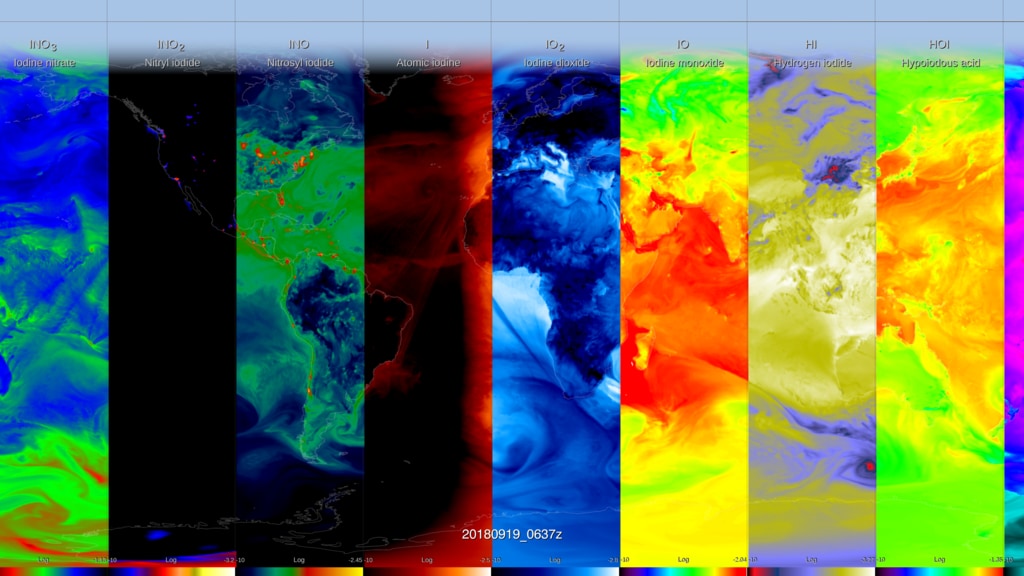NASA Models the Complex Chemistry of Earth's Atmosphere
Music: "Interconnecting Threads" by Axel Tenner [GEMA]; "Night Drift" by Andrew Michael Britton [PRS], David Stephen Goldsmith [PRS], from Universal Production Music
Watch this video on the NASA Goddard YouTube channel.
Complete transcript available.
Air pollution can appear as a gray or orange haze enveloping a city. What the naked eye can’t see are the hundreds of chemical reactions taking place to produce that pollution. NASA science can reveal a more complete picture of atmospheric chemistry.
A NASA visualization shows 96 chemical species that help form one common air pollutant — surface ozone. While ozone in the stratosphere is critical to maintaining life on earth, surface ozone is a toxic gas to most plant and animal species. This visualization uses the GEOS Composition Forecasting (GEOS-CF) computer model, which incorporates 240 chemical species and how they interact with each other and the weather through over 700 chemical reactions. All of these chemical reactions directly or indirectly impact the formation of ozone.
Capturing such complexity requires satellites, the GEOS-CF model, and a supercomputer all working in concert. As the visualization progresses, it cycles through chemicals loosely grouped into seven ‘families’ based on their physical and chemical properties:
• Ox
• Extended HOx family
• Hydrocarbons
• Isoprene oxidation
• Aerosols
• Halogens
• Extended NOx family
More information on each family can be found on the visualization webpage.
The dynamic behavior of some of these chemical species can indicate certain events in the atmosphere. The model covers the time period from July 22, 2018 to October 2, 2018, which includes several notable atmospheric events. Both the Carr Fire and the Mendocino Complex Fire, occurring in late July 2018, released a large amount of hydrocarbons and extended HOx, which can be seen in the model. The latter-occurring Hurricane Florence is also visible, as indicated by the impacted halogens in this atmospheric model.
Satellites observe chemical species in the atmosphere, both those emitted from natural and human sources and those formed from other pollutants. Yet, even several hundred thousand observations a day leave data gaps. Merging satellite data with NASA’s GEOS-CF model yields not only a snapshot of chemistry throughout the atmosphere at any given time but also the ability to predict air quality worldwide.
This model makes a 5-day forecast daily using the NASA Center for Climate Simulation’s Discover supercomputer. Developed jointly with several government and non-profit partners, these forecasts offer a new tool for academic researchers, government scientists, air quality managers, and the general public. Potential applications include flight campaign planning, support of satellite observations, and mitigation of air pollution.
Credits
Please give credit for this item to:
NASA's Goddard Space Flight Center
-
Scientists
- Lesley Ott (NASA/GSFC)
- Christoph A. Keller (USRA)
- K. Emma Knowland (USRA)
-
Producer
- Katie Jepson (USRA)
-
Visualizer
- Greg Shirah (NASA/GSFC)
-
Writers
- Jarrett Cohen (Global Science and Technology, Inc.)
- Esprit Smith (KBR Wyle Services, LLC)
-
Videographer
- Katie Jepson (USRA)
-
Audio technician
- Matthew R. Radcliff (USRA)
-
Technical support
- Aaron E. Lepsch (ADNET Systems, Inc.)
Release date
This page was originally published on Tuesday, April 14, 2020.
This page was last updated on Wednesday, May 3, 2023 at 1:45 PM EDT.
